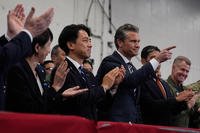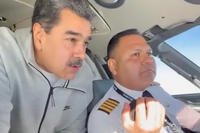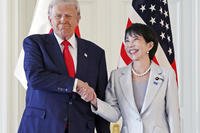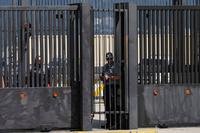As the Department of Defense Education Activity prepares to open more than 77% of its schools this month for in-classroom instruction, the remaining 36 will teach students remotely, including 25 schools in states still struggling to contain the spread of COVID-19.
DoD officials said Thursday that 123 of DoDEA's 160 schools will welcome back students to their campuses in August and early September, including 25 of 50 schools in the U.S., 62 of 64 in Europe and 26 of 45 in the Pacific Region.
Read Next: Special Tactics Airman Who Fought off Taliban Despite Concussion Will Get Silver Star
Students at the 36 schools remaining closed will resume the online instruction most received from their teachers in the spring, logging into virtual classrooms to get daily lessons from their local instructors.
According to DoD, nearly 42% of all DoDEA students will be taught online at the beginning of the school year: 15,540 remotely and 10,028 in the system's virtual school -- a program independent of local brick and mortar schools that maintains its own teachers, curricula and schedule. The remaining 35,989 enrolled in the system will return to in-class instruction.
The virtual school differs from remote learning in that the remote option is taught by teachers to their local students from their own classrooms on installations.
In a press conference with reporters at the Pentagon Thursday, DoDEA Director Thomas Brady said installation commanders have been working with administrators and staff to ensure that the schools are ready for students by obtaining personal protective equipment, organizing classrooms to meet social distancing guidelines and designing schedules to minimize transmission between students and teachers.
Locations that will begin the 2020-2021 academic year remotely include schools in Okinawa, two other locations in Japan and Bahrain. The 25 schools in the U.S. moving to remote learning include ones at major military installations including Fort Bragg, North Carolina; Fort Benning and Fort Stewart, Georgia; Maxwell Air Force Base and Fort Rucker, Alabama; Fort Jackson, South Carolina; and several schools in Puerto Rico.
The reopening of most DoD schools comes as President Donald Trump ramps up pressure on systems to reopen. On Monday, he held an event at the White House with parents, teachers and researchers to make his case for in-classroom learning.
"One thing we've learned during this horror show of the China plague is that virtual is not as good as being there," Trump said during the meeting. "For a long time, we've been hearing how great it would be, how great it would be. Well, we've had the ultimate sample -- right? -- namely the whole country, practically, and it's not as good."
Trump has released guidance containing eight steps for reopening schools safely, including the use of masks when social distancing isn't possible, frequent hand washing and sanitizing, minimizing large gatherings indoors and maintaining good hygiene "and ventilation" in schools.
The president has said federal funding for schools not holding in-class instruction should go directly to students to enable them to find other options or to schools that are open.
With more than 77% of its schools opening across the globe, DoDEA is outpacing schools in the U.S., where roughly 44% of all students will receive in-classroom instruction, according to Burbio, a data service.
Teachers unions that represent DoDEA instructors continue to cite concerns about the health and safety of their members and advocate for remote opening. Union officials say they are worried that teachers will be at risk for contracting the virus and they may be required to clean their own classrooms in addition to their teaching duties.
"DoDEA expects teachers to somehow clean every surface within a classroom while simultaneously educating children," FEA President Brian Chance said in a statement last month.
"DoDEA is refusing to require students to wear masks and is instead expecting children as young as five to remain seated and a safe distance from each other throughout the day. How can a teacher safely interact with a child if that child is not wearing a mask?"
Brady said DoDEA has modified its cleaning contracts to ensure that schools have adequate custodial staff to sanitize and clean and has "designed instructional material to have a minimal amount of required cleaning." Examples of this include individually bagging and distributing materials like blocks or Legos for young students.
"We aren't expecting teachers to be doing custodial work," Brady said. "There are areas that they will need to watch and they have been instructed to do that."
When students return to their schools, they will notice the absence of some extracurricular activities, such as football and other contact sports, which Brady acknowledged may be a disappointment.
"We follow the [National Federation of State High School Associations] guidance on this and there will be some sports -- track and field, golf, swimming, but non-contact and limited number of adults so they do it safely. That's about the extent of that," Brady said.
Pentagon spokesman Jonathan Hoffman said DoD must consider the health and safety of the family members of service members, which he called a “readiness issue.”
"We have an obligation to the family members that are serving to take care of their kids, of their families, so they are prepared," Hoffman said.
Should a teacher or student who has been in a classroom environment test positive, DoDEA guidance calls for closing the school for two to three days for thorough cleaning. If a school remains closed beyond five days for COVID-19, teachers will move to remote learning.
Of the nearly 10,000 students who have opted for DoDEA's K-12 virtual school, 4,330 are located in the U.S., 3,184 are in Europe and 2,158 are in the Pacific region, according to DoD.
The DoD school system has distributed more than 7000 Chrome books and hundreds of WiFi hotspots to ensure that students who opted for the virtual classroom have access to learning, Brady added.
"Everyone acknowledges that COVID is a terrible and difficult disease that we are dealing with. We are potting into place all the measures to mitigate risk. We acknowledge there is a risk and we have given parents and teachers the option, if they believe the risk is more than something they are not willing to take on, we've provided alternatives," Hoffman said.
-- Patricia Kime can be reached at Patricia.Kime@Monster.com. Follow her on Twitter @patriciakime.
Related: DoDEA Gives Students on Military Bases a Break on Grades Due to Coronavirus Woes












